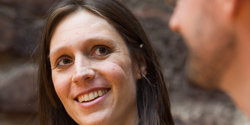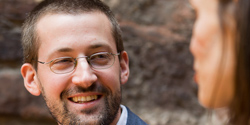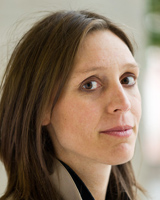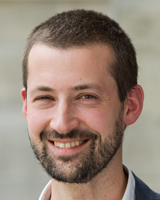Greater Focus on the Other Perspective
The discipline of transcultural studies examines the meeting of cultures from the perspective of both sides - and frequently leads Claudia Brosseder and Georg Christ to cross disciplinary boundaries.
After his PhD thesis, Georg Christ wanted one thing above all: to put some distance between himself and theoretical discourse. So he applied for a job as military observer in the Near East. He wanted to go on patrol on the Golan Heights and experience first-hand what happens when different cultures meet. But when his superiors at UNO learned that he had a PhD and spoke Arabic, they quickly found another position for him - in their Jerusalem headquarters. “I was back to analysing texts.

Christ's colleague Claudia Brosseder also wanted to explore the world. Her habilitation project on Andean culture was supported with an endowed award by the German state of Bavaria. This allowed her to travel the world and conduct research in government, church and private archives in five South American countries. She also made interesting discoveries in the Latin American archives of Spain, Italy and the USA. “If you're interested in pre-colonial Andean culture, that's the only way to go”, she says. “Written sources alone aren't enough - you also have to look at pictures and architecture, archaeological sites and Andean cult sites for clues."
As a microhistorian, explains Georg Christ, he looks at the village to see the world, investigating major questions on a small scale. He doesn't want to develop a new understanding of culture or find a successor for the cumbersome and hackneyed term of interculturality. His aim is to paint a more accurate picture of cultures using a transdisciplinary approach. Christ experiments with new techniques and forms of organisation, with interdisciplinary cooperation, digital card indexes and geoinformation systems.

“We want to systematically investigate how cultures meet, and each culture should have its own say”, says Claudia Brosseder. She has chosen the multifaceted Andean culture as a research subject, wanting to better understand the indigenous world of the Andean population - without relying solely on the writings of the colonialists. To this end, she invited researchers from Latin America, the U.S. and other European countries to Heidelberg. “Some Peruvian scholars have knowledge of details and correlations that's been neglected for a long time”, she says. With their help Brosseder wants to ensure that the history of the Andean world between the 16th and 18th centuries is not just told from the perspective of the Christian missionaries. That history is to be offset against information from indigenous sources and compared with archaeological and ethnological findings.
Meticulously, the historian collects every bit of detailed information she can find - yet always steps back again to look at the big picture. “I ask the same of my PhD students”, she says. “I want them to put the pieces together and find answers to the big questions.” How does religion contribute to the development of an ethnic and cultural identity? What is the role played by rituals that Christian missionaries dismissed as magic and superstition? What is Andean religion anyway? These are the questions that Brosseder wants to answer - using more than texts. She includes ethnological information, examines archaeological artefacts and tries to interpret images as an independent source of information.
In selecting scientists for her junior research group, Claudia Brosseder made sure that each member brought his or her own perspective to the team. Currently, the group consists of an ethnologist, a historian and an archaeologist - with two as yet unstaffed positions for a linguist and an art historian.
Likewise, mediaevalist Georg Christ didn't hire other experts from his own field of specialisation, but instead chose an economic historian, an anthropologist and an Islamic studies scholar for his group. Both Brosseder and Christ want to explore their subject from a diachronic perspective, across eras and disciplines. For Christ, this may mean looking at bank crises over a period of 1000 years. “In this way, I can investigate questions that would be highly politicised today”, he says. Integration in modern societies, he adds, is better understood where it is not endangered by ideological definitions of culture - in the (seemingly) distant past, for instance.
For his PhD thesis, Christ investigated the diaspora of Venetian merchants in Alexandria. “Whenever Islam came into contact with Christianity in the past, the result wasn't just a clash of two cultures”, he explains. “Nothing as simple as that - in fact, there were many conflicts between many cultures. The Venetian merchants were pioneers who paved the way for a more or less peaceful coexistence. But when a deal went wrong, cultural differences were a welcome excuse for failures, and this was recorded in the most frequently read written sources. “Any attempt to define cultures along conflict lines creates more questions than it answers”, Christ has found. All too often, these conflict lines run within and across cultures, and conflict stimulates constructive exchange. To arrive at this conclusion, the researcher studied the letters, tax returns and accounts of Venetian merchants - “microscopic work”, as he terms it.
Perhaps that is the question at the core of transculturalism - how cultures change through contact with the Other. What remains after the exchange? “There really aren't any clearly defined, homogeneous cultures”, states Christ. “Cultures borrow from each other, they copy and change. And still, concepts based on our 'own' versus a 'foreign' culture are so powerful and deeply rooted in our minds that they can trigger conflicts”.
Today Christ wants to compare how Hanseatic cities on the Baltic Sea and population centres in the Mediterranean adapted to climate changes and how they reacted to mass mortality - in the times of the plague, for instance - or to the influx of new inhabitants. “A major change can be both a disaster and a chance. It can turn cities into ghost towns or into prosperous seaports. But what makes the difference”?
The reaction of people from different cultural areas to changes that shaped the economy in the Mediterranean and the Baltic region is something that Christ can't simply read up on. He must reconstruct it, often in cooperation with specialists from other subjects. To learn more about certain smuggling practices for which there are no direct historical sources, he uses a database that his research group created together with computer scientists and other historians. The archive and literature sources in the database and the huge amounts of data on people, ships, events and places allow the scientists to track the paths of ships, merchants and even individual goods. The analysis in a simple geoinformation system shows how spices or silks disappeared, were traded on illegally and then reappeared on the market. “This gives us a look behind the scenes, even if other sources are scarce”, says Christ. In the working group for methods and applications (Kolleg für Methoden und Anwendungen, MAK) that he coordinates, Christ consults with researchers from other disciplines - computer scientists and geographers, archaeologists and art historians.
Claudia Brosseder observes how cultures adapt after coming into contact, but also how they resist each other. “Even though the pressure to adapt was very high, most people of the Andean population are proud of their Inca and pre-Inca heritage”. In which regions did people adapt more readily, and which regions or people preserved more of the old way of life? These are the questions that Brosseder asks herself as she studies her sources. There is no map at the end of her research process - she still prefers to put her findings into words. Still, she brings geography and history closer to each other. “We should see ourselves more as sister disciplines again”, she says. In a new project with Heidelberg geographer Bertil Mächtle, she compares historical sources from Peru with his environmental history archives - drill cores and peat samples from the region around Lake Titicaca. She wants to know how a favourable climate might have influenced religious beliefs.
As heads of independent junior research groups, Claudia Brosseder and Georg Christ enjoy a great deal of freedom in choosing their research approaches and subjects. “Our jobs give us a lot of leeway and the chance to work independently, but they also involve a great deal of responsibility”, says Christ. Brosseder serves on the University Council because she wants to improve perspectives for young scientists in Heidelberg in the long term. “Right now, the University has to be glad if we are offered chairs elsewhere. But the aim should be to keep the best of us in Heidelberg”. The Excellence Initiative has allowed Georg Christ and Claudia Brosseder to break new ground - a solid foundation is not yet in place.
Short Biographies
PD Dr. Claudia Brosseder
 Claudia Brosseder studied history and philosophy in Munich and at Princeton University, USA. In 2002 she earned her PhD from LMU with a thesis on the history of German astrology and its ties to other scientific disciplines in the 16th century. She worked as a researcher in Peru and Stanford, USA, before becoming a professor at Stetson University in Florida in 2007. Two years later, in 2009, she completed her habilitation in modern history at LMU. In 2008 the historian became head of a junior research group in transcultural studies under the heading of “Cultures in Dialogue in the Andean World”. She is currently publishing a book on the world of Andean religious specialists during the colonial period and their exchange with Europeans and Afro-Americans in 16th to 18th century Peru.
Claudia Brosseder studied history and philosophy in Munich and at Princeton University, USA. In 2002 she earned her PhD from LMU with a thesis on the history of German astrology and its ties to other scientific disciplines in the 16th century. She worked as a researcher in Peru and Stanford, USA, before becoming a professor at Stetson University in Florida in 2007. Two years later, in 2009, she completed her habilitation in modern history at LMU. In 2008 the historian became head of a junior research group in transcultural studies under the heading of “Cultures in Dialogue in the Andean World”. She is currently publishing a book on the world of Andean religious specialists during the colonial period and their exchange with Europeans and Afro-Americans in 16th to 18th century Peru.
Dr. Georg Christ
 Georg Christ studied history, economics and Islamic studies in Switzerland. During his PhD project on the diaspora of Venetian merchants in mediaeval Alexandria at the University of Basel, he spent several months studying in archives in Venice, Cairo and Alexandria. After earning his degree he served a term of fourteen months as a military observer for the United Nations in the Near East. In 2008, he became head of a junior research group in transcultural studies at Heidelberg University. The research subject of his group is “Trading Diasporas in the Eastern Mediterranean (1250 – 1450)” - that was also the theme of the international conference “Union in Separation"that was organised by Christ and his group. Georg Christ is currently working on his habilitation.
Georg Christ studied history, economics and Islamic studies in Switzerland. During his PhD project on the diaspora of Venetian merchants in mediaeval Alexandria at the University of Basel, he spent several months studying in archives in Venice, Cairo and Alexandria. After earning his degree he served a term of fourteen months as a military observer for the United Nations in the Near East. In 2008, he became head of a junior research group in transcultural studies at Heidelberg University. The research subject of his group is “Trading Diasporas in the Eastern Mediterranean (1250 – 1450)” - that was also the theme of the international conference “Union in Separation"that was organised by Christ and his group. Georg Christ is currently working on his habilitation.

